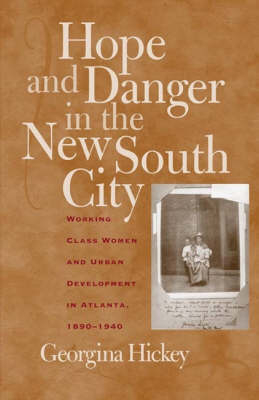
Hope and Danger in the New South City
Working-class Women and Urban Development in Atlanta, 1890-1940
Seiten
2003
University of Georgia Press (Verlag)
978-0-8203-2333-6 (ISBN)
University of Georgia Press (Verlag)
978-0-8203-2333-6 (ISBN)
- Titel ist leider vergriffen;
keine Neuauflage - Artikel merken
Using newspapers, municipal documents, government investigations, organizational records, oral histories and photographs, this text relates the experience of working-class women, across lines of race, to the process of urban development in Atlanta, US, between 1890 and 1940.
For Atlanta, the early decades of the twentieth century brought chaotic economic and demographic growth. Women - black and white - emerged as a visible new component of the city's population. As maids and cooks, secretaries and factory workers, these women served the "better classes" in their homes and businesses. They were enthusiastic patrons of the city's new commercial amusements and the mothers of Atlanta's burgeoning working classes. In response to women's growing public presence, as Georgina Hickey reveals, Atlanta's boosters, politicians, and reformers created a set of images that attempted to define the lives and contributions of working women. Through these images, city residents expressed ambivalence toward Atlanta's growth, which, although welcome, also threatened the established racial and gender hierarchies of the city.
Using period newspapers, municipal documents, government investigations, organizational records, oral histories, and photographic evidence, Hope and Danger in the New South City relates the experience of working-class women across lines of race - as sources of labor, community members, activists, pleasure seckers, and consumers of social services - to the process of urban development. Linking major events of the era - including a race riot, a tuberculosis scare, a sensationalized murder trial, and the founding of the first citywide charity organization - to the public dialogue about working women, Hickey devotes chapters to such topics as work, leisure, social welfare, public health, and politics and law. By looking anew at the iconography and public discourse of a city, Hickey pushes us to understand urban development outside of strictly economic realms. We see in new ways how issues of respectability, morality, and social order are bound up with what it means to live in, and be part of, a particular city.
For Atlanta, the early decades of the twentieth century brought chaotic economic and demographic growth. Women - black and white - emerged as a visible new component of the city's population. As maids and cooks, secretaries and factory workers, these women served the "better classes" in their homes and businesses. They were enthusiastic patrons of the city's new commercial amusements and the mothers of Atlanta's burgeoning working classes. In response to women's growing public presence, as Georgina Hickey reveals, Atlanta's boosters, politicians, and reformers created a set of images that attempted to define the lives and contributions of working women. Through these images, city residents expressed ambivalence toward Atlanta's growth, which, although welcome, also threatened the established racial and gender hierarchies of the city.
Using period newspapers, municipal documents, government investigations, organizational records, oral histories, and photographic evidence, Hope and Danger in the New South City relates the experience of working-class women across lines of race - as sources of labor, community members, activists, pleasure seckers, and consumers of social services - to the process of urban development. Linking major events of the era - including a race riot, a tuberculosis scare, a sensationalized murder trial, and the founding of the first citywide charity organization - to the public dialogue about working women, Hickey devotes chapters to such topics as work, leisure, social welfare, public health, and politics and law. By looking anew at the iconography and public discourse of a city, Hickey pushes us to understand urban development outside of strictly economic realms. We see in new ways how issues of respectability, morality, and social order are bound up with what it means to live in, and be part of, a particular city.
GEORGINA HICKEY is an assistant professor of history at the University of Michigan, Dearborn.
| Erscheint lt. Verlag | 28.2.2003 |
|---|---|
| Zusatzinfo | 25 b&w photographs |
| Verlagsort | Georgia |
| Sprache | englisch |
| Maße | 156 x 235 mm |
| Themenwelt | Geschichte ► Allgemeine Geschichte ► Neuzeit (bis 1918) |
| Geisteswissenschaften ► Geschichte ► Regional- / Ländergeschichte | |
| Geschichte ► Teilgebiete der Geschichte ► Kulturgeschichte | |
| Naturwissenschaften ► Geowissenschaften ► Geografie / Kartografie | |
| Sozialwissenschaften ► Soziologie ► Gender Studies | |
| Sozialwissenschaften ► Soziologie ► Makrosoziologie | |
| ISBN-10 | 0-8203-2333-0 / 0820323330 |
| ISBN-13 | 978-0-8203-2333-6 / 9780820323336 |
| Zustand | Neuware |
| Informationen gemäß Produktsicherheitsverordnung (GPSR) | |
| Haben Sie eine Frage zum Produkt? |
Mehr entdecken
aus dem Bereich
aus dem Bereich
Giordano Bruno - ein ketzerisches Leben
Buch | Hardcover (2024)
C.H.Beck (Verlag)
29,90 €
das dramatische 16. Jahrhundert
Buch | Hardcover (2024)
Rowohlt Berlin (Verlag)
34,00 €


